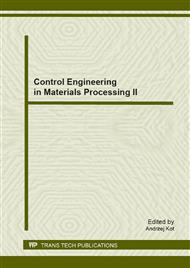[1]
M. Shahinpoor, "Ionic polymeric conductor nano composites (IPCNCs) as distributed nanosensors and nanoactuators," Advances in Science and Technology, vol. 54, p.70–81, 2008.
Google Scholar
[2]
R. P. Hamlen, C. E. Kent, S. N. Shafer, "Electrolytically activated contractile polymer," Nature, vol. 6, p.1149–1150, 1965.
DOI: 10.1038/2061149b0
Google Scholar
[3]
Y. Bar-Cohen, Electroactive Polymer (EAP) Actuators as Artificial Muscles: Reality, Potential, and Challenges, ser. Spie Press Monograph. Society of Photo Optical, 2004. [Online]. Available: http://books.google.pl/books?id=uxqgkdqE9FIC
DOI: 10.1117/3.547465
Google Scholar
[4]
Z. Chen and X. Tan, "A control oriented and physics based model for ionic polymer-metal composite actuators," 2008.
Google Scholar
[5]
S. Nemat-Nasser, S. Zamani, Y. Tor, "Effect of solvents on the chemical and physical properties of ionic polymer-metal composites," Journal of Applied Physics, vol. 99, no. 10, p.104902, 2006. [Online]. Available: http://link.aip.org/link/?JAP/99/104902/1
DOI: 10.1063/1.2194127
Google Scholar
[6]
K. M. Farinholt, "Modeling of dynamic behaviors of ionic polymer transducers for sensing and actuation," Ph.D. dissertation, Virginia Polytechnic Institute, 2005.
Google Scholar
[7]
M. Shahinpoor, K. J. Kim, "Ionic polymer-metal composites: I. fundamentals," Smart Materials and Structures, vol. 10, no. 4, p.819, 2001. [Online]. Available: http://stacks.iop.org/0964-1726/10/i=4/a=327
DOI: 10.1088/0964-1726/10/4/327
Google Scholar
[8]
M. Shahinpoor, K. J. Kim, "Ionic polymer-metal composites: IV. industrial and medical applications," Smart Materials and Structures, vol. 14, no. 1, p.197, 2005. [Online]. Available: http://stacks.iop.org/0964-1726/14/i=1/a=020
DOI: 10.1088/0964-1726/14/1/020
Google Scholar
[9]
J. Najem, S. A. Sarles, B. Akle, D. J. Leo, "Biomimetic jellyfish-inspired underwater vehicle actuated by ionic polymer metal composite actuators," Smart Materials and Structures, vol. 21, 2012.
DOI: 10.1088/0964-1726/21/9/094026
Google Scholar
[10]
B. R. Martin, "Energy harvesting applications of ionic polymers," Master's thesis, Virginia Polytechnic Institute and State University, 2005.
Google Scholar
[11]
K. Nowak, Master's thesis, AGH University of Science and Technology, Cracow, Poland, 2011. (in Polish)
Google Scholar
[12]
J. Kwaśniewski, I. Dominik, Acta mechanica et automatica, vol. 3, 2011. (in Polish)
Google Scholar


